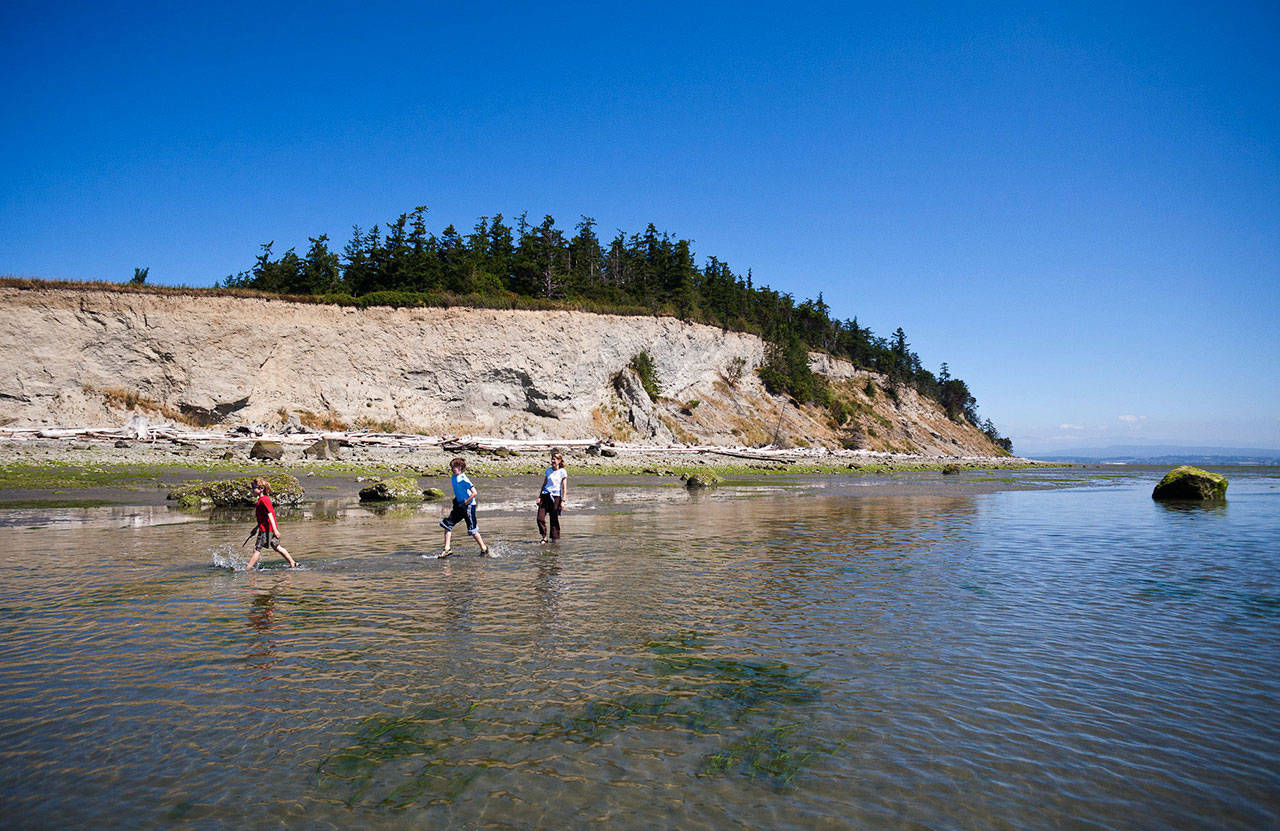By Val Schroeder
As long-time resident and teacher on Camano Island, I am surrounded by Washington’s natural beauty every day.
Across from Triangle Cove lies one of these beautiful places — 129 acres of critical wildlife habitat called Barnum Point. This elusive, inaccessible land is home to eagles, deer, coyotes, raptors, woodpeckers and frogs — lots of frogs.
Barnum Point includes a mile of pristine shoreline along Port Susan Bay, through which more than 20,000 shorebirds migrate in fall and spring. Some, like thousands of dunlin, stay for the winter. This stop along the Pacific flyway also provides a critical feeding and roosting spot for wintering waterfowl. For these reasons and more, the Greater Skagit and Stillaguamish Delta has been recognized as a national priority for preservation.
Positioned across from the mouth of the Stillaguamish River, the tidelands and shoreline of Barnum Point serve as habitat for juvenile salmon leaving the river. The point is the gateway to the Triangle Cove estuary, a refuge for these young salmon, and to Kristoferson Creek, the main salmon-bearing creek on Camano. Juvenile coho swim up the small creek to the beaver marsh to grow and mature for a year’s time, before swimming back to Port Susan Bay and the sea.
I haven’t minded only seeing Barnum Point from a distance. It’s doing what it does best: providing habitat for the critters. However, we now have an opportunity to ensure that this natural area remains wildlife habitat while providing opportunities for us humans to visit. The Whidbey Camano Land Trust is working with willing landowners and the community to preserve Barnum Point’s ecosystem and to provide a refuge for bird watching, hiking, beach walking and just being in the natural world.
Portions of the Barnum Point area have been protected, but preserving the additional acreage maintains an ecosystem of feeder bluffs and estuaries, intact riparian forest and forest bluffs and important bird habitat.
To make this project a reality, the Whidbey Camano Land Trust has applied for two Washington Wildlife and Recreation Program (WWRP) grants, in conjunction with Island County.
If you haven’t heard of the WWRP before, you’re not alone. But don’t underestimate the importance of this little-known program: The WWRP is Washington’s primary tool for protecting its natural spaces and creating outdoor recreational opportunities.
Funded through the state’s capital construction budget, the WWRP has successfully leveraged more than $1.3 billion for more than 1,200 projects, protecting over 260,000 acres of parks, farmland and wildlife habitat. The program also improves parks, maintains open space and contributes to creating jobs, revenue and increased quality of life throughout the state. Key leaders such as state Rep. Norma Smith, one of Camano Island’s legislators, have shown strong support for the program.
The Washington Wildlife and Recreation Coalition, which is the primary advocate for the WWRP, has asked Gov. Jay Inslee and the legislature for $120 million in funding for the program in 2017-19. These funds will go directly to supporting projects like Barnum Point, projects that bring communities together.
I’m proud to say that even my students are working hard to protect this valuable land.
As Make a Difference Day honorees, my high school senior English students received a $10,000 grant to contribute to a community organization. After proposing and ranking several worthy causes, they selected the Barnum Point preservation project. I couldn’t have been happier. The students chose to become a part of the Barnum Point legacy.
And what a legacy it is. They can now proudly tell their future children and grandchildren how they helped save this gorgeous and ecologically important land for generations to come.
But they can’t do it alone. We need your voice to help get funding for projects like this one. If you support funding open spaces and preserving habitat in Washington, please call your elected officials and let them know that you support $120 million for WWRP.
Val Schroeder teaches high school and lives on Camano Island. In 2016 she was honored with the Snohomish Conservation District’s Lifetime Achievement Award.
Correction: This commentary has been corrected to show that the Washington Wildlife and Recreation Program has leveraged more than $1.3 billion for more than 1,200 projects statewide.
Talk to us
> Give us your news tips.
> Send us a letter to the editor.
> More Herald contact information.

























